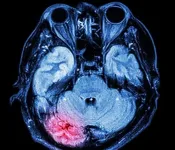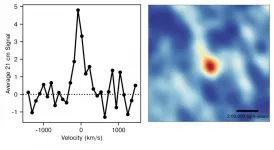A mechanism through which 'good' viruses kill 'bad' bacteria and block their reproduction
An important step in the battle against antibiotic-resistant bacteria
2021-06-07
(Press-News.org) The battle against antibiotic-resistant bacteria: A new study at Tel Aviv University revealed a mechanism through which "good" viruses can attack the systems of "bad" bacteria, destroy them and block their reproduction. The researchers demonstrated that the "good" virus (bacteriophage) is able to block the replication mechanism of the bacteria's DNA without damaging its own, and note that the ability to distinguish between oneself and others is crucial in nature. They explain that their discovery reveals one more fascinating aspect of the mutual relations between bacteria and bacteriophages and may lead to a better understanding of bacterial mechanisms for evading bacteriophages, as well as ways for using bacteriophages to combat bacteria.
The study, published recently in PNAS - Proceedings of the National Academy of Sciences, was led by Prof. Udi Qimron, Dr. Dor Salomon, Dr. Tridib Mahata and Shahar Molshanski-Mor of the Sackler Faculty of Medicine. Other participants included Prof. Tal Pupko, Head of the Shmunis School of Biomedicine and Cancer Research and also of the new AI and Data Science Center ; Dr. Oren Avram of the George S. Wise Faculty of Life Sciences; and Dr. Ido Yosef, Dr. Moran Goren, Dr. Miriam Kohen-Manor and Dr. Biswanath Jana of the Sackler Faculty of Medicine.
Prof. Qimron explains that the antibiotic resistance of bacteria is one of the greatest challenges faced by scientists today. One potential solution may lie in further investigation of the targeted eradication of bacteria by "good" bacteriophages; namely, understanding bacteriophage mechanisms for taking over bacteria as a basis for the development of new tools to combat bacterial pathogens.
With this intention in mind, the current study unveiled the mechanism by which the bacteriophage takes control of the bacteria. The researchers found that a bacteriophage protein uses a DNA-repair protein in the bacteria to "cunningly" cut the bacteria's DNA as it is being repaired. Since the bacteriophage's own DNA has no need for this specific repair protein, it is protected from this nicking procedure. In this way the "good" bacteriophage does three important things: it distinguishes between its own DNA and that of the bacteria, destroys the bacteria's genetic material, and blocks the bacteria's propagation and cell division.
Prof. Qimron adds: "The bacteriophage takes advantage of the bacterial DNA's need for repair, while the bacteriophage itself has no need for this specific kind of repair. In this way the bacteriophage destroys the bacteria without suffering any damage to itself. The ability to distinguish between oneself and others is of enormous importance in nature and in various biological applications. Thus, for example, all antibiotic mechanisms identify and neutralize bacteria only, with minimal effect on human cells. Another example is our immune system, which is geared toward maximum damage to foreign factors, with minimal self-injury."
The researchers discovered the process by searching for types of bacterial variants not impacted by this bacteriophage mechanism - those that have developed "immunity" to it. This inquiry led them to the specific bacterial mechanisms affected by the bacteriophage takeover. "We found that the 'immune' bacterial variants simply stopped repairing their DNA in ways that are vulnerable to the bacteriophage attack, thereby evading the bacteriophage's destructive mechanism. Shedding more light on the ways in which bacteriophages attack bacteria, our findings may serve as a tool in the endless battle against antibiotic-resistant bacteria," concludes Prof. Qimron.
INFORMATION:
[Attachments] See images for this press release:

ELSE PRESS RELEASES FROM THIS DATE:
2021-06-07
IgA nephropathy (IgAN) is a chronic kidney disease occurring in young adults and is one of the most common reasons for kidney transplantation in this age group. IgAN is the most common form of glomerulonephritis (GN), i.e., immunologically induced inflammation of the renal glomeruli. It is characterized by glomerular deposition of immune complexes containing immunoglobulin A (IgA), and by a complex inflammatory response and progressive loss of kidney function. For many decades, IgAN has therefore been treated with anti-inflammatory or strong immunosuppressive agents. ...
2021-06-07
Wider clean chemistry applications of the extraordinary Vortex Fluidic Device - invented by Flinders University's Professor Colin Raston - are likely in the wake of new research that has been published outlining the seemingly endless possible uses.
The defining paper on understanding fluid flow in the Vortex Fluidic Device has just been comprehensively explained in an article published in Nanoscale Advances (DOI: 10.1039/D1NA00195G).
This took more than 100,000 experiments to work out - and Professor Raston hopes this publication will encourage more researchers to embrace the VFD and explore yet more innovative applications for this ingenious device.
"How fluid flows is one of the grand challenges of science," says Professor Raston. "What we have been ...
2021-06-07
A world-first international study led by the University of South Australia has identified a new drug to stop athletes developing dementia after sustaining repeated head injuries in their career.
The link between concussion and neurogenerative diseases is well established, but new research findings could halt the progression of chronic traumatic encephalopathy (CTE) in sportspeople who sustain repeated blows to the head.
CTE is a progressive and fatal brain disease associated with the accumulation of a protein known as hyperphosphorylated tau which affects cognition and behaviour.
In a paper published in Scientific Reports, ...
2021-06-07
LA JOLLA, CALIF. - June 7, 2021 - A preclinical study led by scientists at Sanford Burnham Prebys has established that AAV8-TNAP-D10--a gene therapy that replaces a key enzyme found in bone--may be a safe and effective single-dose treatment for hypophosphatasia (HPP). The study, published in the Journal of Bone and Mineral Research and performed in a murine model of the disease, further supports advancing the therapy toward human clinical trials.
"This is the most promising gene therapy study to date demonstrating a successful increase in life span, and improvement ...
2021-06-07
Monash University researchers have provided a fundamental advance regarding how T cells become activated when encountering pathogens such as viruses.
The recent study published in Science, co-led by Professor Nicole La Gruta, Professor Jamie Rossjohn and Professor Stephanie Gras with first author Dr Pirooz Zareie from the Monash Biomedicine Discovery Institute, have found that T Cells need to recognise pathogens in a particular orientation in order to receive a strong activating signal.
T cells play a key role in the immune system by eliminating invading pathogens, such as viruses, and it is crucial to understand ...
2021-06-07
When we inhale isolated coronavirus particles, more than 65% reach the deepest region of our lungs where damage to cells can lead to low blood oxygen levels, new research has discovered, and more of these aerosols reach the right lung than the left.
Lead author of the study Dr Saidul Islam, from the University of Technology Sydney, said while previous research has revealed how virus aerosols travel through the upper airways including the nose, mouth and throat - this study was the first to examine how they flow through the lower lungs.
"Our ...
2021-06-07
Finding the hypothetical particle axion could mean finding out for the first time what happened in the Universe a second after the Big Bang, suggests a new study published in Physical Review D on June 7.
How far back into the Universe's past can we look today? In the electromagnetic spectrum, observations of the Cosmic Microwave Background -- commonly referred to as the CMB -- allow us to see back almost 14 billion years to when the Universe cooled sufficiently for protons and electrons to combine and form neutral hydrogen. The CMB has taught us an inordinate amount about the evolution of the cosmos, but photons in the CMB were released 400,000 years after the Big Bang making it extremely challenging to learn about the history of ...
2021-06-07
TAMPA, Fla. (June 4, 2021) — Type 1 diabetes (T1D) is an autoimmune disease in which a misdirected immune system gradually destroys healthy pancreatic islet β cells, resulting in a lack of insulin. The exact cause of T1D remains unknown. However, β cell-reactive autoantibodies can be detected in circulating blood months to years before diagnosis, raising the possibility of intervening to stop or delay T1D before children develop the disease.
Monitoring the number, type, and concentration of autoantibodies appearing in the blood can help predict the long-term risk of progression from autoimmunity to symptomatic T1D.
Now new findings suggest that measuring how patterns ...
2021-06-07
A research team from the University of Copenhagen and University of Helsinki demonstrates it is possible to predict individual preferences based on how a person's brain responses match up to others. This could potentially be used to provide individually-tailored media content -- and perhaps even to enlighten us about ourselves.
We have become accustomed to online algorithms trying to guess our preferences for everything from movies and music to news and shopping. This is based not only on what we have searched for, looked at, or listened to, but also on how these activities compare to others. Collaborative filtering, as the technique is called, uses hidden ...
2021-06-07
A team of astronomers from the National Centre for Radio Astrophysics (NCRA-TIFR) in Pune, and the Raman Research Institute (RRI), in Bangalore, has used the Giant Metrewave Radio Telescope (GMRT) to measure the atomic hydrogen gas content of galaxies 9 billion years ago, in the young universe. This is the earliest epoch in the universe for which there is a measurement of the atomic hydrogen content of galaxies. The new result is a crucial confirmation of the group's earlier result, where they had measured the atomic hydrogen content of galaxies 8 billion years ago, and pushes our understanding of galaxies to even earlier in the universe. ...
LAST 30 PRESS RELEASES:
[Press-News.org] A mechanism through which 'good' viruses kill 'bad' bacteria and block their reproduction
An important step in the battle against antibiotic-resistant bacteria






